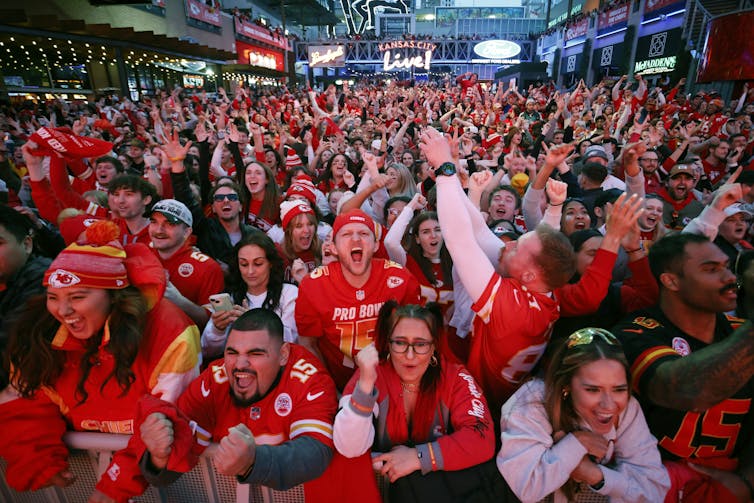Why do sports keep changing their rules? We count 4 main reasons
- Written by Kim Encel, Sessional Academic and UNESCO Consultant, Deakin University

The Australian Football League’s 2023 season is kicking off with changes afoot. Three rule changes, in fact, which may either please or infuriate commentators and fans.
One change will prevent players awarded a free kick or mark from attempting to win a 50-metre penalty by feigning a handball, in the hope an opposition player will move off their mark and violate the “stand” rule.
Another aims to prevent time-wasting by penalising players with a 50-metre penalty if they change their mind about standing a mark or leaving the protected area.
The third concerns the 30 seconds allowed to players when taking a set shot on goal; umpires will now give a time warning at 25 seconds but not at 15 seconds.
Rule changes like these never cease to spark debate among diehard fans about “leaving the sport alone”.
Australian Rules football has consistently changed its rules throughout its history. But it’s also true that rule changes or tweaks are becoming increasingly common. This is a trend in professional sport around the world. The US National Basketball Association, for example, changes rules almost every year.
Why? Sometimes the reason is to reduce injuries. But often it’s to do with the bottom line – which is that professional sport is a business that depends on delivering an audience to broadcasters. In a competitive media market there are big incentives to change rules to make the sport more exciting for fans and more conducive to commercial sponsors.
Four reasons for rule changes
Our research[1] points to professional sport leagues changing rules for four main reasons: to reduce the risk of injury; to make games easier to officiate; to enhance the sport’s spectacle; and to create space for advertising during broadcasts.
The US National Football League, for example, has explicitly said[2] it champions “changes that promote more scoring and more exciting plays”.
In the AFL, scoring is often the focus for rule changes, because more goals make the sport more exciting to watch while allowing for more advertising breaks. In 2021, for example, advertising breaks immediately following a goal were extended from 45 seconds to one minute to allow for increased commercial airtime.
Read more: Have the NRL's rule changes made boring blowouts the norm? The stats say no[3]
A short history of ‘Aussie Rules’ rules
The first documented Australian Rules football code was instituted by the Melbourne Football Club in 1859. There were ten simple rules, such as “tripping and pushing are both allowed” and “a goal must be kicked fairly between the posts”. Some of these original rules remain. Others have changed dramatically. Now there are more than 100 “laws of the game[4]”.
The rules of the women’s competition, the AFLW, have been changed more than 16 times since it began in 2017. In the same time there have been more than 20 rule changes in the men’s competition.
Changing rules and regulations in complex environments such as professional sport is challenging, and professional leagues don’t always get it right.
Trialling a change before permanently implementing it is crucial to avoid negative or unintended consequences.
In 2016, before the inaugural AFLW season, the AFL trialled three different rules it hoped would make the game as exciting as possible.
These were the “last-touch” rule whereby a free kick would be awarded to the opponent of the player last touching the ball before it went out of bounds; a “density” rule requiring players to spread out more evenly across the field; and having 16 players per side instead of 18, to reduce the scrimmages that lead to more stoppages.
Read more: Grand design: why the AFL structure is unique – and has enabled competitive balance[5]
These rule modifications were trialled in exhibition matches. But based on data analysis and feedback from spectators, players, coaches and managers, the AFL concluded most of the changes added nothing to the spectacle of the game.
As a result just one on-field rule change was made in the first AFLW season: the 16-a-side rule.
Rule changes are made to benefit the sport, but introducing them will never be an easy process. Getting the balance right between evolving commercial needs and tradition will always be tricky, and some people will never be happy.
But if attention has been paid to the process, with feedback from all stakeholders, it’s more likely new rules will be accepted and quickly integrated into the fabric of the sport.
References
- ^ research (www.inderscienceonline.com)
- ^ explicitly said (operations.nfl.com)
- ^ Have the NRL's rule changes made boring blowouts the norm? The stats say no (theconversation.com)
- ^ laws of the game (resources.afl.com.au)
- ^ Grand design: why the AFL structure is unique – and has enabled competitive balance (theconversation.com)
Authors: Kim Encel, Sessional Academic and UNESCO Consultant, Deakin University
Read more https://theconversation.com/why-do-sports-keep-changing-their-rules-we-count-4-main-reasons-201861














